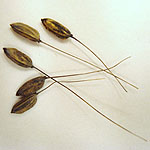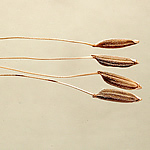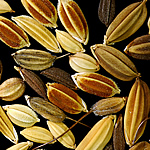Utilizing Genetic Diversity

Over the last decade, an international network of rice researchers has begun to explore the genetic potential of the wild ancestral species, O. rufipogon, by crossing it with a wide array of elite O. sativa cultivars (31). Advanced backcross (BC2) populations were constructed in which transgressive variation - the occurrence of progeny displaying phenotypes more extreme than either parent - could be genetically dissected. Using a common set of molecular markers to identify 'wild QTLs' associated with enhanced performance in wild x cultivated populations in different regions of the world, we have been able to show that specific O. rufipogon introgressions consistently confer superior performance for a variety of agronomic and yield-related traits (flowering time, panicle size, seed size and shape, number of seeds per plant) (18; 32; 43; 44; 46; 47; 50). The superior performance of the transgressive offspring is due to the introgression of particular alleles from the low-performing O. rufipogon parent into the elite O. sativa parent background. The gene x gene (G X G) interaction in these offspring results in improved phenotypic performance.

The group of researchers involved in the 'wild QTL' network described above has focused on the use of a single accession of O. rufipogon in combination with an array of different elite recurrent parents representing both inbred and hybrid combinations from three of the major sub-populations of O. sativa (i.e., temperate japonica, tropical japonica and indica). This offers a well-defined genetic system and has clearly demonstrated that selected introgressions from O. rufipogon confer a consistent and agronomically relevant advantage in diverse genetic backgrounds grown in very different environments (31).

Parallel experiments by other researchers in India, Korea, China and the Philippines have used O. sativa landraces and diverse O. rufipogon accessions as donors in combination with elite O. sativa recurrent parents, and all have shown similar results (5; 18; 21; 27; 34; 52). This body of work confirms that valuable transgressive phenotypes can be reliably identified when elite O. sativa parents are crossed with divergent wild or landrace accessions, and is consistent with the hypothesis that inter-specific and inter-sub-specific crosses offer rich opportunities for exploiting the genetic variability and breeding potential of the primary Oryza gene pool.
It is of interest to compare breeding strategies of rice with those of maize, barley, wheat and other grass species because these crop species have fundamentally different mating habits, histories of domestication, ploidy levels and breeding contexts. Integration of knowledge about evolution and natural population structure of domesticated species, combined with emerging sequence and functional genomics information will lead to better management of germplasm resources and more efficient utilization of natural variation for crop improvement
